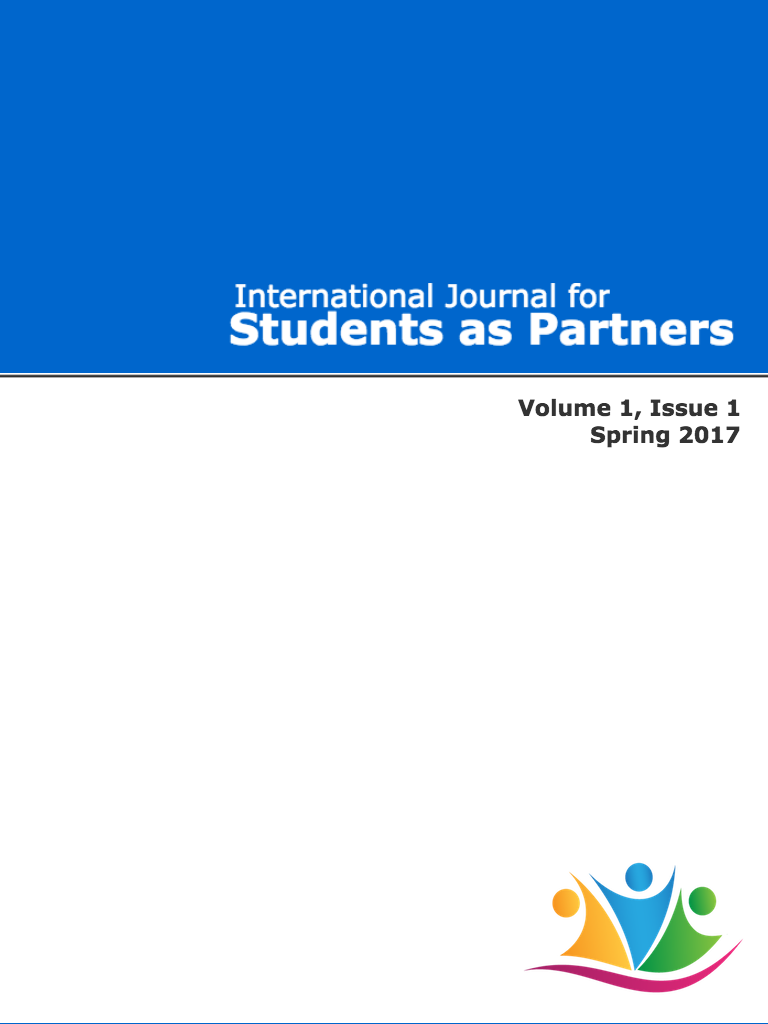Students as Partners in the Real World – A Whole-Institution Approach
DOI :
https://doi.org/10.15173/ijsap.v1i1.3079Mots-clés :
students as partners, student engagement, whole of institution approachRésumé
Students as Partners (SaP) is an approach to student engagement that has gained much traction in recent years. Evidence shows that it adds value to the learning experience and provides opportunities for students to develop the capabilities needed in their future pathways. This paper documents one university’s approach to embedding partnerships in its institutional culture. The paper begins by contextualising the process in relation to wider institutional goals and outlines the three phases of implementation. This case study argues that to enable a whole-institution approach to SaP, it has been necessary to invest in strategies at a number of levels that enable partnership, from high-end policy and protocols to providing opportunities for staff and students to shape their own partnerships.
Téléchargements
Références
Bergmark, U., & Westman, S. (2016). Co-creating curriculum in higher education: promoting democratic values and a multidimensional view on learning. International Journal for Academic Development, 21(1), 28-40. Retrieved from http://www.tandfonline.com/doi/full/10.1080/1360144X.2015.1120734
Bovill, C., & Bulley, C. (2011). A model of active student participation in curriculum design: exploring desirability and possibility. Retrieved from https://www.researchgate.net/publication/279448454_A_model_of_active_student_participation_in_curriculum_design_exploring_desirability_and_possibility
Bridgstock, R. (2016). Future Capable. Retrieved from http://www.futurecapable.com/
Buckley, A. (2014). How radical is student engagement?(And what is it for?). Student Engagement and Experience Journal, 3(2), 1-23. Retrieved from http://research.shu.ac.uk/SEEJ/index.php/seej/article/view/95
Carey, P. (2016). The impact of institutional culture, policy and process on student engagement in university decision-making. Perspectives: Policy and Practice in Higher Education, 1-8. Retrieved from http://www.tandfonline.com/doi/full/10.1080/13603108.2016.1168754
Cook-Sather, A. (2014). Student-faculty partnership in explorations of pedagogical practice: a threshold concept in academic development. International Journal for Academic Development, 19(3), 186-198. doi:www.tandfonline.com/doi/abs/10.1080/1360144X.2013.805694
Cook-Sather, A., Bovill, C., & Felten, P. (2014). Engaging students as partners in learning and teaching: A guide for faculty: John Wiley & Sons.
Healey, M., Flint, A., & Harrington, K. (2014). Engagement through partnership: Students as partners in learning and teaching in higher education. Retrieved from York: https://www.heacademy.ac.uk/engagement-through partnership-students-partners-learning-and-teaching-higher-education
Kuh, G. D., Kinzie, J., Schuh, J. H., & Whitt, E. J. (2011). Fostering student success in hard times. Change: The magazine of higher learning, 43(4), 13-19. Retrieved from http://www.tandfonline.com/doi/full/10.1080/00091383.2011.585311
Luescher-Mamashela, T. M. (2013). Student representation in university decision making: good reasons, a new lens? Studies in Higher Education, 38(10), 1442-1456. Retrieved from http://dx.doi.org/10.1080/03075079.2011.625496
Naumann, F. L., Coulter, T., Brancato, T., Rueckert, C., Shaw, N., & Lane, M. (2016). Students as partners in curriculum design: Working with students to improve student engagement in group work. Manuscript in preparation.
QUT. (2017). QUT Real World Learning Vision. Retrieved from https://www.qut.edu.au/about/strategic-ambitions/real-world-learning-2020-vision
Seale, J., Gibson, S., Haynes, J., & Potter, A. (2015). Power and resistance: Reflections on the rhetoric and reality of using participatory methods to promote student voice and engagement in higher education.
Journal of further and Higher Education, 39(4), 534-552. Retrieved from http://www.tandfonline.com/doi/abs/10.1080/0309877X.2014.938264
Shaw, N., & Tredinnick, J. (2017). Students as Partners Guide Retrieved from https://qutvirtual4.qut.edu.au/group/staff-staging/teaching/rwl/students-as-partners
Thomas, L. (2012). Building student engagement and belonging in Higher Education at a time of change: final report from the What Works? Student Retention and Success programme. Retrieved from http://www.phf.org.uk/wp-content/uploads/2014/10/What-Works-report-final.pdf
Vuori, J. (2014). Student engagement: buzzword of fuzzword? Journal of Higher Education Policy and Management, 36(5), 509-519. Retrieved from http://www.tandfonline.com/doi/abs/10.1080/1360080X.2014.936094
Téléchargements
Publié-e
Comment citer
Numéro
Rubrique
Licence
(c) Tous droits réservés Authors 2017

Cette œuvre est sous licence Creative Commons Attribution 4.0 International.
Authors retain copyright and grant the journal right of first publication with the work simultaneously licensed under a Creative Commons Attribution License that allows others to share the work with an acknowledgement of the work's authorship and initial publication in this journal.
Authors are able to enter into separate, additional contractual arrangements for the non-exclusive distribution of the journal's published version of the work (e.g., post it to an institutional repository or publish it in a book), with an acknowledgement of its initial publication in this journal.
Authors are permitted to post their work online (e.g., in institutional repositories or on their website) prior to and during the submission process - this applies to the submitted, accepted, and published versions of the manuscript. This can lead to productive exchanges, as well as earlier and greater citation of published work (see The Effect of Open Access).


